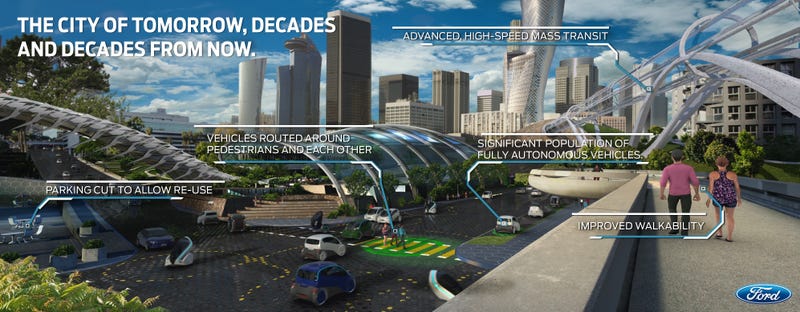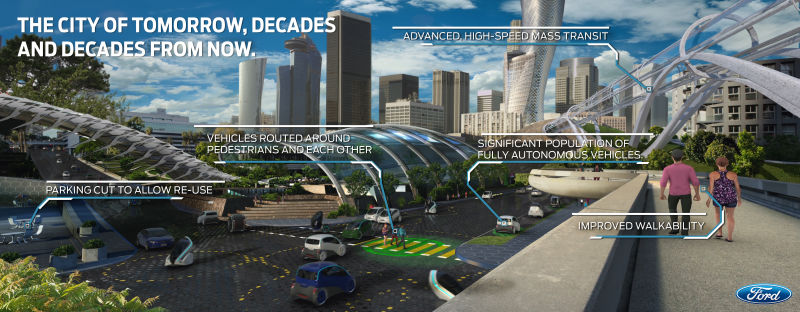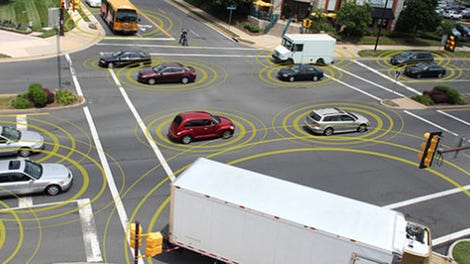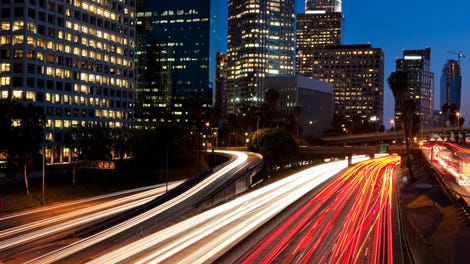
Besides the bonkers official announcements from Ford about a new Bronco and Ranger, the automaker made waves at this week’s Detroit Auto Show with a TED talk-like event about how to transform cities of the future with the technology we’re enraptured with today—electric and autonomous vehicles, all that good stuff. But without a significant influx in infrastructure investments, the warm and fuzzy picture of a Smart City is a pipe dream.
Advertisement
I didn’t make it to the event, but there seemed to be plenty of buzz about what Ford’s pitching as the “City of Tomorrow.” Here’s how Ford describes it:
Ford’s City of Tomorrow looks at how near-term mobility advancements – including autonomous and electric vehicles, ride-sharing and ride-hailing and connected vehicles – interact with urban infrastructure and create a transportation ecosystem.
For example, Ford is imagining a world in which reconfigurable roads fluidly respond to commuter needs and traffic flow. Bikes and drones provide last-mile solutions for both people and goods.
More efficient roadways, constructed and reconfigured in a way to accommodate autonomous technology and connected vehicles that can drive around pedestrians—this is fine!
Advertisement
But the company’s Monday morning press conference neglected some fine print: It’s going to cost a hell of a lot to make happen. And if history guides us, we’re completely fine with spending too little to maintain decent transportation infrastructure. (Granted, Ford seems to be implicitly acknowledging that more resources are needed, but an explicit overture would really clarify things.)
And the need for new infrastructure to handle this technology is vast: Electric vehicles need spots to charge on the roadway, self-driving cars need smooth roads to function smoothly, our traffic management systems will need to be pristine in order for cars to be more efficient and talk with infrastructure like traffic lights.
As we reported last year, the feds describe the state of our transportation system as fucking bleak:
Sponsored
There’s something else we’re going to have to do to avoid a future crisis with our transportation system, and that’s spend money on it. Foxx said that we basically called it a day with our highways around 1992 or so; investment in transportation continues to decline.
The report says that we need to spend $120 billion on highways and bridges between 2015 and 2020, while spending at all levels of government is just $83 billion; we need $43 billion for public transit, while it’s currently at a dismal $17 billion. Today, our road system scores a mere “D+” grade when compared to the rest of the world. Surely, America can do better.
This situation isn’t unlike the effusive optimism for a self-driving revolution across the U.S.; it can happen, but will probably be confined to select cities willing to appropriate a flush transportation budget. If it’s going to materialize in the form of federal programs, we’ll need more money — which, again, there hasn’t been any impetus to boost transportation spending.
The Drivenotes that Ford later hosted a discussion with several mayors who’ve bought into the idea, including Detroit’s mayor, Mike Duggan, and the importance of adequate funding in achieving a more-efficient city was definitely highlighted, but clearly understated.
Advertisement
Advertisement
Detroit’s probably the exact city Ford has in mind when it considered this initiative, and it’s a wonderful example to illustrate its disconnect with reality.
A few years back, for what seemed like an eternity, Republican Michigan Governor Rick Snyder made grand symbolic gestures to goad the state’s also Republican-led, tax-averse legislature into passing a $1.2 billion road infrastructure package. After nearly three years of work, he signed a feeble version of it into law. A victory! But not really.
That’s because Michigan, according to anyone with a pulse and who drives its pothole-ridden roads on a regular basis, needs to spend more far more. At least a billion dollars more per year than what Snyder signed, some analyses have suggested. State spending on roadways and infrastructure dictates municipal spending on roadways and infrastructure, and without an extra boost … you get my point.
Advertisement
This also reminded me of the episode at last year’s Los Angeles Auto Show with Volvo North American CEO Lex Kerssemakers. The guy is trying to show off the automaker’s semi-autonomous prototype, but it—at times—refused to drive.
“It can’t find the lane markings!” Kerssemakers bleated to Los Angeles Mayor Eric Garcetti, who was driving at the time. “You need to paint the bloody roads here!”
Just how bleak are we talking here? The U.S. Department of Transportation says 65 percent of the nation’s roads are shit, Reuters reports, and our transportation infrastructure system rated 12th in a recent World Economic Forum global competitiveness report. Outgoing DOT head Anthony Foxx summed up the gloomy infrastructure forecast for his likely-successor Elaine Chao, in a 11-page exit memo released last week:
Advertisement
Advertisement
The next Secretary of Transportation will not simply work on building roads and bridges and ensuring safe travel. The next administration is entering a period of advanced automated technologies in transportation, an infrastructure system that continues to work for some and against others in society, dramatic demographic shifts, an increase in extreme weather events in a changing climate, and a backlog of projects needed across the country with not enough resources to address it. Future administrations should, if the United States is to remain competitive in the global economy, devote significant time and energy to securing the resources needed to keep America competitive.
Put simply: We have to do better. We’re not, whatsoever.
The $4 billion, 10-year plan for autonomous car research that was announced last year by the Obama administration is helpful, but it addresses one piece of the puzzle — how to make this technology work, regulatory issues — and that doesn’t include painting the bloody roads.
Advertisement
Again, that’s not to downplay what Ford’s pitching here. But if you’re going to pitch an ostentatious vision for cities of the future, at least toss in a call to arms to actually spend what’s needed to possibly make it a reality.















